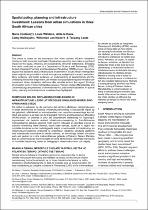 ResearchSpace
ResearchSpace
Spatial policy, planning and infrastructure investment: lessons from urban simulations in three South African cities
JavaScript is disabled for your browser. Some features of this site may not work without it.
- ResearchSpace
- →
- Research Publications/Outputs
- →
- Journal Articles
- →
- View Item
| dc.contributor.author |
Coetzee, M

|
|
| dc.contributor.author |
Waldeck, L

|
|
| dc.contributor.author |
Le Roux, Alize

|
|
| dc.contributor.author |
Meiklejohn, C

|
|
| dc.contributor.author |
Van Niekerk, Cornelia W

|
|
| dc.contributor.author |
Leuta, T

|
|
| dc.date.accessioned | 2015-11-12T07:40:48Z | |
| dc.date.available | 2015-11-12T07:40:48Z | |
| dc.date.issued | 2014-05 | |
| dc.identifier.citation | Coetzee, M, Waldeck, L, Le Roux, A, Meiklejohn, C, Van Niekerk, W and Leuta, T. 2014. Spatial policy, planning and infrastructure. Town and Regional Planning, Vol. 64, pp 1-9. | en_US |
| dc.identifier.issn | 1012-280X | |
| dc.identifier.uri | http://hdl.handle.net/10204/8272 | |
| dc.description | Copyright: 2014: University of the Free State (UoFS) | en_US |
| dc.description.abstract | This article is based on the assumption that more spatially efficient investment choices in both economic and basic infrastructure spending can make a significant impact on the equity, efficiency and sustainability of human settlements. Emerging from work conducted as part of a Department of Science and Technology (DST)-funded Integrated Planning and Development Modelling (IPDM) project, the article argues that decisions about infrastructure investment in South African metropolitan areas ought to be grounded in robust and rigorous analysis and scenario evaluation. More evidence, and better evidence, an understanding of spatial trends and the underlying forces that shape them, are needed to support planning and infrastructure investment. Urban simulation platforms offer valuable tools in this regard. Findings of simulation work in three metropolitan areas (eThekwini, Nelson Mandela Bay and Johannesburg) are presented to demonstrate this, and some implications for spatial policy, planning and infrastructure investment are highlighted. | en_US |
| dc.language.iso | en | en_US |
| dc.publisher | University of the Free State (UoFS) | en_US |
| dc.relation.ispartofseries | Worklist;14693 | |
| dc.subject | Integrated planning and development modelling | en_US |
| dc.subject | Spatial planning | en_US |
| dc.subject | Metropolitan areas | en_US |
| dc.title | Spatial policy, planning and infrastructure investment: lessons from urban simulations in three South African cities | en_US |
| dc.type | Article | en_US |
| dc.identifier.apacitation | Coetzee, M., Waldeck, L., Le Roux, A., Meiklejohn, C., Van Niekerk, C. W., & Leuta, T. (2014). Spatial policy, planning and infrastructure investment: lessons from urban simulations in three South African cities. http://hdl.handle.net/10204/8272 | en_ZA |
| dc.identifier.chicagocitation | Coetzee, M, L Waldeck, Alize Le Roux, C Meiklejohn, Cornelia W Van Niekerk, and T Leuta "Spatial policy, planning and infrastructure investment: lessons from urban simulations in three South African cities." (2014) http://hdl.handle.net/10204/8272 | en_ZA |
| dc.identifier.vancouvercitation | Coetzee M, Waldeck L, Le Roux A, Meiklejohn C, Van Niekerk CW, Leuta T. Spatial policy, planning and infrastructure investment: lessons from urban simulations in three South African cities. 2014; http://hdl.handle.net/10204/8272. | en_ZA |
| dc.identifier.ris | TY - Article AU - Coetzee, M AU - Waldeck, L AU - Le Roux, Alize AU - Meiklejohn, C AU - Van Niekerk, Cornelia W AU - Leuta, T AB - This article is based on the assumption that more spatially efficient investment choices in both economic and basic infrastructure spending can make a significant impact on the equity, efficiency and sustainability of human settlements. Emerging from work conducted as part of a Department of Science and Technology (DST)-funded Integrated Planning and Development Modelling (IPDM) project, the article argues that decisions about infrastructure investment in South African metropolitan areas ought to be grounded in robust and rigorous analysis and scenario evaluation. More evidence, and better evidence, an understanding of spatial trends and the underlying forces that shape them, are needed to support planning and infrastructure investment. Urban simulation platforms offer valuable tools in this regard. Findings of simulation work in three metropolitan areas (eThekwini, Nelson Mandela Bay and Johannesburg) are presented to demonstrate this, and some implications for spatial policy, planning and infrastructure investment are highlighted. DA - 2014-05 DB - ResearchSpace DP - CSIR KW - Integrated planning and development modelling KW - Spatial planning KW - Metropolitan areas LK - https://researchspace.csir.co.za PY - 2014 SM - 1012-280X T1 - Spatial policy, planning and infrastructure investment: lessons from urban simulations in three South African cities TI - Spatial policy, planning and infrastructure investment: lessons from urban simulations in three South African cities UR - http://hdl.handle.net/10204/8272 ER - | en_ZA |





